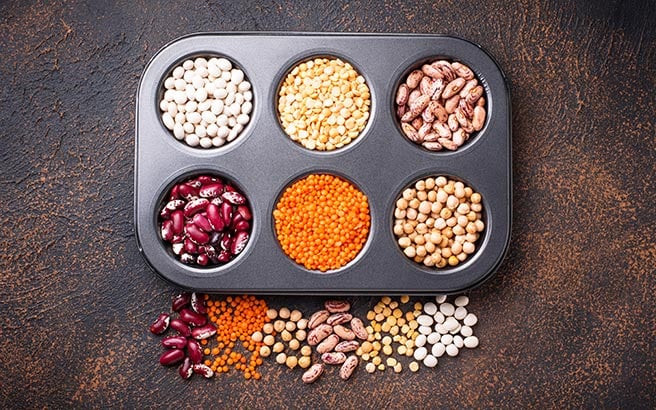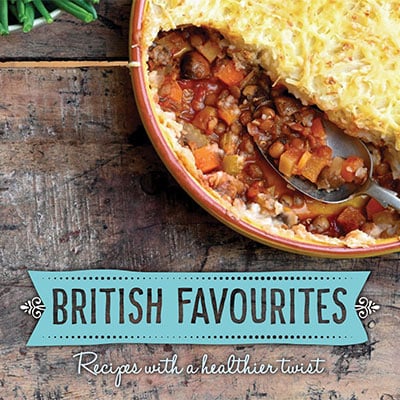What are pulses?
Pulses are part of the legume family and legumes are plants whose fruit grows in a pod. The word pulse is used to refer to the dried edible seed or grain that grows in a pod.
Pulses include all dried beans, peas and lentils, including:
- Chickpeas
- Black-eyed peas
- Red, brown, green and yellow lentils
- Kidney beans
- Cannellini beans
- Butter beans
- Haricot beans
- Pinto beans
- …and many more
There’s even archaeological evidence that humans were eating pulses, such as chickpeas and lentils, as far back as 8000 BC, so they’ve been powering us for more than a few millennia.
Why are pulses so great?
In many ways, they’re the original super food.
- They’re a really good source of protein, which makes them an ideal choice if you’re trying to eat more plant-based foods.
- Pulses are also full of fibre. In fact, pulses have around three times more fibre than brown rice – all that fibre is great for keeping you, ahem, regular, and a high-fibre diet has been found to help lower the risk of bowel cancer, heart disease and type 2 diabetes.
- Pulses are a good source of iron – great if you’re a vegetarian, but also if you’re trying to cut back on red meat.
- And if you’re still not convinced, they’re also chock-full of other nutrients, such as B vitamins (including folate), potassium and zinc.
What about cooking with pulses?
 As an ingredient, pulses are remarkably versatile – they can be included in any meal of the day, as a main dish, side or even in snacks and baked goods.
As an ingredient, pulses are remarkably versatile – they can be included in any meal of the day, as a main dish, side or even in snacks and baked goods.
Pulses can often be a substitute for rice, pasta or potatoes – kale and lentil stew or trout and warm lentil salad are good examples.
Their other common use is as a red meat replacement – try these spicy bean burgers or this bean chilli recipe to get started.
Tinned or dried?
If you’re short on time, or are a slightly less-confident cook, using tinned pulses is probably an easier option. Pulses from a can are pre-cooked – think chickpeas or lentils – so you can achieve quicker results.
This means you only need to heat them up, or even add them straight into a salad if using cold. Try to choose the ones that have no added salt or sugar, and rinse well before using.
You might wonder why bother with the dried variety then? Well, although they take longer to prepare, they usually give a slightly richer flavour and there are more options available. Do a search on your preferred supermarket’s website and you’ll see all the varieties.
Typically, most dried pulses need to be soaked (overnight is best) and cooked before they can be eaten. In some cases – such as dried kidney beans and soya beans – this is to ensure you get rid of any toxins.
However, don’t assume that all dried pulses take hours of preparation. Red and yellow lentils can usually be rinsed and then cooked straight from their packet in under 30 minutes (try this Indian lentil soup, for example).
Guidelines differ depending on the pulse you’re using, so it’s best to check the cooking instructions before you start.
> Find a bean recipe to get started
> Try one of these tasty lentil recipes
Are pulses an environmental saviour?
From a taste and nutrition perspective, we wholeheartedly endorse pulses. What’s more, they’re also great for the planet.
With the increased focus on eating more plant-based foods, it’s great to know that pulses are remarkably sustainable.
For example, growing 1kg of lentils requires a third of the water compared with the same amount of chicken, and less than 10% of the water needed to produce 1kg of beef.
Pulses also improve the soil quality, which extends the length of time farmland can be used, reduces the need for chemical fertilisers, plus they also create a more varied landscape for animals, especially insects.
Many varieties are also drought and frost-resistant, meaning they are better placed to withstand some of the extreme weather caused by climate change.
Nice price
It probably goes without saying, but pulses tend to be much kinder on your purse. For example, a 400g tin of chickpeas, beans or lentils costs between 50p–£1.
Dried versions usually work out even cheaper, given that they more than double in size and weight once cooked.
Compare that with how much meat costs, for example, and if you’re trying to cut back on your supermarket bill, there’s a good argument for picking pulses.
What about the wind problem?
Let’s face it, we all know the one big objection to eating beans (and other pulses). There’s no easy way to say this – beans make you fart!
What we all need to realise, though, is that it’s a good thing. It’s a sign that your body – and specifically your digestion – is working as it should.
Beans and lentils are packed with complex carbs called oligosaccharides – these are basically sugars that the body can’t break down properly. And, because the small intestine can’t fully digest them, when they reach the lower intestine bacteria feed on them and that’s what causes wind.
What’s good about them, though, is that they’re prebiotic – this means that they boost the growth of good gut bacteria, which in turn provide additional health benefits.
It’s also worth pointing out that if you increase the amount of pulses you eat, your body will get used to them and any increase in wind is likely to be temporary.
If you’re still unconvinced, then some other researchers have looked into the smell caused by gas from different foods.
Although pulses can cause us to fart, bad smells aren’t necessarily their fault. Too many white carbs, dairy products or green veg, such as broccoli, cauliflower and cabbage, are also sometimes to blame.
Basically, most types of food can cause gas in some form, and 99% of it doesn’t smell at all.
Where next?
Have we convinced you? Why not try making something with beans, peas or lentils today.
> Get started by searching for a recipe now


